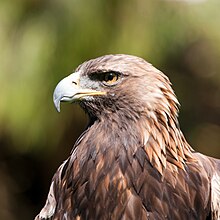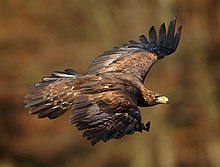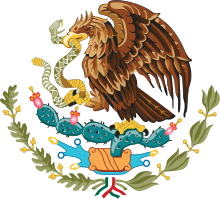Golden eagle
| Golden Eagle | |
|---|---|

| |
| Adult of the North American subspecies Aquila chrysaetos canadensis | |
| Scientific classification | |
| Kingdom: | |
| Phylum: | |
| Class: | |
| Order: | |
| Family: | |
| Genus: | |
| Species: | A. chrysaetos
|
| Binomial name | |
| Aquila chrysaetos | |

| |
| Light brown : Wintering only Brown : Breeding only | |
| Synonyms | |
|
Falco chrysaëtos Linnaeus, 1758 | |
The Golden Eagle (Aquila chrysaetos) is one of the best known birds of prey in the Northern Hemisphere. Like all eagles, it belongs to the family Accipitridae. Once widespread across the Holarctic, it has disappeared from many of the more heavily populated areas. Despite being extirpated from some its former range or uncommon, the species is still fairly ubiquitous, being present in Eurasia, North America, and parts of Africa. The highest density of nesting Golden Eagles in the world lies in southern Alameda County, California. These birds are dark brown, with lighter golden-brown plumage on their heads and necks.
Golden Eagles use their agility and speed combined with extremely powerful talons to snatch up prey including rabbits, marmots, ground squirrels, and large mammals such as foxes, wild and domestic cats, mountain goats, ibex, and young deer. They will also eat carrion if prey is scarce, as well as reptiles. Birds, including large species up to the size of swans and cranes as well as ravens and Greater Black-backed Gulls have all been recorded as prey. They have even been known to attack and kill fully grown roe deer. The Eurasian subspecies is used to hunt and kill wolves in many native communities, where their status is regarded with great mystic reverence.
Golden Eagles maintain territories that may be as large as 155 square kilometres (60 sq mi). They are monogamous and may remain together for several years or possibly for life. Golden Eagles nest in high places including cliffs, trees, or human structures such as telephone poles. They build huge nests to which they may return for several breeding years. Females lay from one to four eggs, and both parents incubate them for 40 to 45 days. Typically, one or two young survive to fledge in about three months.
Description

The Golden Eagle is a large, dark brown raptor with broad wings. Its size is variable: it ranges from 66 to 100 cm (26 to 39 in) in length and it has a typical wingspan of 1.8 to 2.34 m (5.9 to 7.7 ft). In the largest race (A. c. daphanea) males and females weigh 4.05 kg (8.9 lb) and 6.35 kg (14.0 lb). In the smallest subspecies (A. c. japonensis), the sexes weigh, respectively, 2.5 kg (5.5 lb) and 3.25 kg (7.2 lb).[2][3][4][5] The maximum size of this species is a matter of some debate, although the normal upper weight limit for a large female is around 6.8 kg (15 lb) and large races are the heaviest representatives of the Aquila genus.[6] Captive birds have been measured up to a wingspan of 2.81 m (9.2 ft) and a mass of 12.1 kg (27 lb) (the latter figure was for an eagle bred for the purposes of falconry).[6] The sexes are similar in plumage but are considerably dimorphic in size, with females rather larger than males.[7] Adults are primarily brown, with gold on the back of the crown and nape, and some grey on the wings and tail.[8] tarsal feathers range from white to dark brown. In addition, some birds have white "epaulettes" on the upper part of each scapular feather tract.[9] The bill is dark at the tip, fading to a lighter horn color, with a yellow cere.[10]
Juveniles have a darker, unfaded color, white patches in the remiges which may be divided by darker feathers,[11] and a large amount of white on the tail with a black terminal band.[7] Occasionally upper wing feathers of juveniles are also white, or birds lack white on the wing entirely. As the bird ages, the amount of white on wings and tail diminishes, and adult plumages is usually acquired by the fifth year.[11]
Taxonomy and systematics
This species was first described by Linnaeus in his 1758 Systema naturae as Falco chrysaetos.[12] The type locality was given simply as "Europa"; it was later fixed to Sweden. It was moved to the new genus Aquila by French ornithologist Mathurin Jacques Brisson in 1760.[13]
The Golden Eagle is one of the largest eagles in the genus Aquila, which are distributed almost worldwide. The latest research indicates it forms a worldwide superspecies with Verreaux's Eagle, Gurney's Eagle, and the Wedge-tailed Eagle.[citation needed]
Subspecies and distribution
There are six extant subspecies of Golden Eagle that differ slightly in size and plumage.
- Aquila c. chrysaetos (Linnaeus, 1758) – The nominate subspecies. Eurasia except Iberian peninsula, east to western Siberia.
- Aquila chrysaetos canadensis (Linnaeus, 1758) – North America.
- Aquila chrysaetos kamtschatica Severtzov, 1888 – Eastern Siberia, from the Altay to the Kamchatka Peninsula. Often included in A. c. canadensis.
- Aquila chrysaetos daphanea Severtzov, 1888 – Southern Kazakhstan east to Manchuria and south-west China, along the Himalayas from northern Pakistan in the west to Bhutan in the east.[14]
- Aquila chrysaetos homeryi Severtzov, 1888 – Iberian peninsula and North Africa, east to Turkey and Iran.
- Aquila chrysaetos japonica Severtzov, 1888 – Japan and Korea.
The larger Middle Pleistocene Golden Eagles of France (and possibly elsewhere) are referred to a paleosubspecies Aquila chrysaetos bonifacti, and the huge specimens of the Late Pleistocene of Liko Cave (Crete) have been named Aquila chrysaetos simurgh.[15]
Ecology
Feeding

The Golden Eagle is one of the most powerful predators in the avian world. While they do show strong local preferences for certain prey, Golden Eagles are first and foremost opportunists and virtually any small to mid-sized animal may be predated if encountered. Nearly 200 species of mammal and bird have been recorded as golden eagle prey.[3] Prey selection is largely determined by the local availability and abundance of the prey species.[3] Most prey taken are around half the weight of the predating eagle, with a typical prey weight range of 0.5–4 kg (1.1–8.8 lb).[3] Although this eagle will sometimes fly with prey equal to or slightly heavier than their own weight (4–7 kg (8.8–15.4 lb)).[3]
In North America and most of Europe, the predominant prey are leporids (hares and rabbits) and sciurids (ground squirrels, prairie dogs, and marmots). In one North American study, mammals comprised 83.9% of the eagles' diet.[16] In Washington, the Yellow-bellied marmot was eaten significantly more than other species, while in Great Britain and central and alpine Eurasia, the Mountain Hare was taken far more than any other species.[17][3] Additional mammals regularly taken include smaller rodents, such as mice, mid-sized mammals such as foxes and the offspring of ungulates such as deer, antelope goats and sheep.[3] At the breeding ground of the caribou, this eagle is one of the most frequent predators of newborn or young calves.[3] Domesticated types of ungulate young are taken as well.[3] There is one confirmed report of a Golden Eagle snatching the cub of a Brown Bear.[18] For juvenile eagles, wintering eagles or eagles that have failed to breed, being able to carry off prey is less important than it is for those who are nesting and such birds are more likely to take large prey that can be left and returned to repeatedly feed on. Wild eagles have exceptionally taken ungulate prey in such circumstances weighing 30 kg (66 lb) or even more.[3] Reptiles are rarely taken over most of the range but prey such as large snakes appears to be fairly common in the southern reaches of its Asian range.[3] During winter months when prey is scarce, Golden Eagles often scavenge on carrion.[19]
After mammals, the secondary important prey group for Golden Eagles are other birds. Various gallinaceous birds (largely phasianids and grouse) are the most significant avian prey.[3] However, virtually any bird, from a Eurasian Jay to a swan, about double the weight of an eagle, is potential prey.[20] In Sweden, birds were found to be the primary prey, with the most common prey species being the Western Capercaillie; while in sub-Arctic regions a strong preference for rock ptarmigan has been noted.[21][3] Golden Eagles are avian apex predators, meaning a healthy adult is not preyed upon. There are records of Golden Eagles killing and eating large raptors such as Gyrfalcons, Northern Goshawks, and Buteo hawks, whether adults, nestlings or eggs.[20] Falcons, skuas, and Buteos like Rough-legged Hawks, which are normally competitors, have worked together to group-mob Golden Eagles that have passed their adjacent nesting areas.[20] In one instance, a Golden Eagle flying in towards a Peregrine Falcon nest was struck and killed by a swooping parent falcon, a reversal of fortune for the falcon given that the much larger eagle is usually dominant over (and a potential predator of) them.[22] More commonly, Golden Eagles kleptoparasitize, or steal prey, from other raptors. While not as large as some vultures, Golden Eagles are usually considerably more aggressive and are capable of driving vultures and other raptors from carrion.[3] Interspecies competition occurs regularly with large Haliaeetus eagles (principally White-tailed and Bald Eagles) and, since these species are of comparable size, strength and tenacity, victory in such conflicts depends on the individual eagle rather than on species.[20]
Reproduction

Golden Eagles usually mate for life. They build several eyries within their territory and use them alternately for several years. These nests consist of heavy tree branches, upholstered with grass when in use. Old eyries may be 2 metres (6.6 ft) in diameter and 1 metre (3.3 ft) in height, as the eagles repair their nests whenever necessary and enlarge them during each use. If the eyrie is situated on a tree, supporting tree branches may break because of the weight of the nest. Certain other animals—birds and mammals too small to be of interest to the huge raptor—often use the nest as shelter. Their predators are just the right size for Golden Eagle prey, and therefore avoid active eyries.
The female lays one to four (usually two) eggs between January and September (depending on the locality). The eggs vary from all white to white with cinnamon or brown spots and blotches. They start incubation immediately after the first egg is laid, and after 40 to 45 days the young hatch.[citation needed] They are covered in fluffy white down and are fed for fifty days before they are able to make their first flight attempts and eat on their own. In most cases only the older chick survives, while the younger one dies without leaving the eyrie. This is due to the older chick having a few days' advantage in growth and consequently winning most squabbles for food. This strategy is useful for the species because it makes the parents' workload manageable even when food is scarce, while providing a reserve chick in case the first-born dies soon after hatching. Golden Eagles invest much time and effort in bringing up their young; once able to hunt on their own, most Golden Eagles survive many years, but mortality even among first-born nestlings is much higher, in particular in the first weeks after hatching.[3] Even with eggs and small nestlings predation on the Golden Eagle is rare. The only known predators of Golden Eagle nests are wolverines and brown bears.[23]
Status and conservation

At one time, the Golden Eagle lived in temperate Europe, North Asia, North America, North Africa, and Japan. In most areas this bird is now a mountain-dweller, but in former centuries it also bred in the plains and the forests. In recent years it has started to breed in lowland areas again, e.g., in Sweden and Denmark.
There was a great decline in Central Europe where they are now essentially restricted to the Apennine, Alps, and Carpathian Mountains. In Britain, the last comprehensive survey of Golden Eagles took place in 2003, and found 442 occupied territories.[24] A less thorough survey in 2007 showed that in addition to large numbers of territories in the Scottish Highlands and the Inner and Outer Hebrides, there were a handful of birds in southern Scotland and northern England.[25] Between 1969 and 2003 they nested in the Lake District, Cumbria.[24]
In Ireland, where it had been extinct due to hunting since 1912, efforts are being made to re-introduce the species. Forty-six birds were released into the wild in Glenveagh National Park, County Donegal, from 2001 to 2006, with at least three known female fatalities since then. It is intended to release a total of sixty birds, to ensure a viable population. In April 2007, a pair of Golden Eagles produced the first chick to be hatched in the Republic of Ireland in nearly a century. The previous attempt to help the birds breed at the Glenveagh National Park had failed.[citation needed]
In North America the situation is not as dramatic, but there has still been a noticeable decline. The main threat is habitat destruction which by the late 19th century already had driven Golden Eagles from some regions they used to inhabit.[26] In the 20th century, organochloride and heavy metal poisonings were also commonplace, but these have declined thanks to tighter regulations on pollution. Within the United States, the Golden Eagle is legally protected by the Bald and Golden Eagle Protection Act.[citation needed]
Available habitat and food are the main limiting factor nowadays. Collisions with power lines have become an increasingly significant cause of mortality since the early 20th century. On a global scale, the Golden Eagle is not considered threatened by the IUCN mainly thanks to the large Asian and American populations.[citation needed]
In human culture

Falconry
Golden Eagles have been used in falconry since the Middle Ages. In Asia, they were used in teams to hunt such animals as deer, antelope and wolves, while their use was reserved for Emperors in Europe.[27] They can be trained for falconry.[28]
Heraldry


The Golden Eagle is the most common national animal in the world, with five nations—Albania, Germany, Austria, Mexico and Kazakhstan—making it the national animal. It is also a common motif in the national symbols of countries that have not officially made it the national animal or national bird. The reasons for this are various, but among the nations that use the Golden Eagle as or in a state symbol, there are two clear traditions that help explain the modern usage. Among European countries, the Golden Eagle was the model for the aquila, the most prominent symbol of the Roman legions and more generally the Roman civilization that had such a powerful impact on Western culture; furthermore, some Roman traditions were carried on by the Byzantine Empire in the Southern and Eastern of Europe and the Holy Roman Empire in Central and Western Europe, transmitting the use of the Golden Eagle to several modern states. This association of the Golden Eagle with Rome has also led to the adoption of similar symbols in other countries; for instance, the adoption of the related and physically similar Bald Eagle as the national bird of the United States was inspired by the conception of the United States as a modern reincarnation of the Roman Republic, a theme that recurs in other elements as well (including the prevalence of neoclassical architecture in American public buildings and the use of Roman terminology—such as naming the upper house of Congress the Senate—to hark back to the Roman model).
Another large tradition of using the Golden Eagle can be found in the Arab world, where the eagle is historically a symbol of power in Arabic poetry, and was according to legend the personal emblem of Saladin. The specific depiction of Golden Eagle legendarily considered to be Saladin's was adopted by the Arab nationalist movement, and currently appears on the arms of Egypt, Iraq, and Palestine; it had previously appeared on the arms of the People's Democratic Republic of Yemen (1967–1990) and on the arms of the Libyan Arab Republic (1970–1972). The current emblem of Yemen displays a Golden Eagle, but it is not that of Saladin.
Religion
In North America
The eagle is a sacred bird in some cultures and the feathers of the eagle are central to many religious and spiritual customs, especially among some Native Americans in the United States and First Nations in Canada, as well as among many of the peoples of Meso-America. Some Native American peoples revere eagles as sacred and the feathers and other parts of Bald and Golden Eagles. Feathers are often worn on Native American headdresses and have been compared to the Bible and crucifix of Christianity. Eagle feathers are often used in various Native ceremonies and are used to honour noteworthy achievements and qualities such as exceptional leadership and bravery.[citation needed] The Golden Eagle is thought to be the origin of the Thunderbird legends of the southwestern United States,[27]
Current United States eagle feather law (50 CFR 22) stipulates that only individuals of certifiable Native American ancestry enrolled in a federally recognized tribe are legally authorized to obtain eagle feathers for religious or spiritual use. Thus, the supply of eagle material for traditional ceremonial use can be guaranteed and ceremonial eagle items can be passed on as heirlooms by their traditional owners without the restrictions that would usually apply. Commercial trade in Golden Eagles or their feathers or body parts is not legalized by these exceptions.[29]
Postage stamps
The Golden Eagle is the eighth-most common bird depicted on postage stamps with 155 stamps issued by 71 stamp-issuing entities.[30][31]
Other
J.R.R. Tolkien used an image of an immature Golden Eagle from T. A. Coward's 1919 work The Birds of the British Isles and Their Eggs for an illustration depicting Bilbo awaking next to Gwaihir.[32]
References
- ^ a b Template:IUCN
- ^ "Golden Eagle, Life History". All About Birds. Cornell Lab of Ornithology. 2009. Retrieved 26 December 2010.
- ^ a b c d e f g h i j k l m n o Watson, Jeff (2011). The Golden Eagle: Second Edition. ISBN 978-0=30017-019-1.
{{cite book}}: Check|isbn=value: invalid character (help) - ^ Raptors of the World by Ferguson-Lees, Christie, Franklin, Mead & Burton. Houghton Mifflin (2001), ISBN 0-618-12762-3
- ^ [1] (2011).
- ^ a b Wood, Gerald (1983). The Guinness Book of Animal Facts and Feats. ISBN 978-0-85112-235-9.
- ^ a b Terres (1980), p. 478
- ^ Clark and Wheeler (2001), p. 241
- ^ Jollie, Malcolm (1947). "Plumage Changes in the Golden Eagle" (PDF). Auk. 64. American Ornithologists' Union: 549–576. Retrieved 27 December 2010.
- ^ Clark, William S (1983). "The field identification of North American eagles" (PDF). North American Birds. 37 (5). American Birding Association: 822–826. Retrieved 27 December 2010.
- ^ a b Liguori, Jerry (2004). "How to Age Golden Eagles" (PDF). Birding. American Birding Association: 278–283. Retrieved 27 December 2010.
- ^ "[Falco] cera lutea, pedibus lanatis, corpore fusco ferrugineo vario, cauda nigra basi cinereo-undulata." - "A [diurnal raptor] with yellow cere, [feathered tarsometatarsus], body dusky brown variegated with rusty, tail black with ashy-waved base." (Linnaeus 1758)
- ^ Brisson (1760). Ornithologie; ou, Méthode contenant la division des oiseaux en ordres, sections, genres, espéces & leurs variétés. &c. Paris: C.J.B. Bauche. pp. 28, 419.
{{cite book}}: Unknown parameter|coauthors=ignored (|author=suggested) (help) - ^ Rasmussen, PC & JC Anderton (2005). Birds of South Asia. The Ripley Guide. Volume 2. Smithsonian Institution & Lynx Edicions. p. 107.
- ^ Sánchez Marco (2004)
- ^ Olendorff, Richard R. (1976). "The Food Habits of North American Golden Eagles". American Midland Naturalist. 95 (1). The University of Notre Dame: 231–236. doi:10.2307/2424254.
- ^ Marr, N. Verne; Knight, Richard L. (1983). "Food Habits of Golden Eagles in Eastern Washington". The Murrelet. 64 (3). Society for Northwestern Vertebrate Biology: 73–77. doi:10.2307/3535265.
- ^ Sørensen, Ole (2008). "Predation by a Golden Eagle on a Brown Bear Cub". 19 (2): 190–193.
{{cite journal}}: Cite journal requires|journal=(help); Unknown parameter|coauthors=ignored (|author=suggested) (help) - ^ Cornell University
- ^ a b c d Cornell University
- ^ Tjernberg, Martin (1981). "Diet of the Golden Eagle Aquila chrysaetos during the Breeding Season in Sweden". Holarctic Ecology. 4 (1). Nordic Society Oikos: 12–19.
- ^ Elibrary.unm.edu (2011).
- ^ [2] (2011).
- ^ a b Mark Holling and the Rare Breeding Birds Panel Report for 2003-4 accessed 4 March 2010.
- ^ Mark Holling and the Rare Breeding Birds Panel (2010). "Rare breeding birds in the United Kingdom in 2007". British Birds. 103: 45–6.
- ^ E.g. Henninger (1906)
- ^ a b Warhol, Tom; Reiter, Chris (2003). Eagles. Marshall Cavendish. pp. 18–19. ISBN 0761415785. Retrieved 1 January 2010.
{{cite book}}: CS1 maint: multiple names: authors list (link) - ^ Hollinshead, Martin (1995). Hawking with golden eagles. Surrey, British Columbia: Hancock House. ISBN 0888393431.
- ^ USDCDN (1986), USFWS-SR (2001), USFWS-OLE (2004a,b), e-CFR (2008)
- ^ Scharning, Kjell. "Bird Stamp Statistics". Theme Birds on Stamps. Retrieved 17 January 2011.
- ^ Scharning, Kjell. "Stamps showing Golden Eagle Aquila chrysaetos". Theme Birds on Stamps. Retrieved 17 January 2011.
- ^ Hammond, Wayne G.; Scull, Christina (1995). J. R. R. Tolkien Artist and Illustrator. Hammersmith, London: HarperCollins. pp. 120–21. ISBN 0-261-10322-9.
{{cite book}}: CS1 maint: multiple names: authors list (link)
Works cited
- Clark, William S.; Wheeler, Brian K. (2001). A field guide to hawks of North America. New York: Houghton Mifflin Company. ISBN 0395670675. Retrieved 26 December 2010.
- Cramp, Stanley, ed. (1979). Handbook of the Birds of Europe the Middle East and North Africa, the Birds of the Western Palearctic, Volume 2: Hawks to bustards. Oxford: Oxford University Press. ISBN 978-0198575054.
- Terres, John K. (1980). "Golden Eagle". The Audubon Society Encyclopedia of North American Birds. New York: Alfred A. Knopf. ISBN 0517032880.
External links
- Kazakh hunter. Fox Hunting with a Golden Eagle - Human Planet: Mountains, preview - BBC One
- Photos Hunting with Golden Eagles
- Golden Eagle videos on the Internet Bird Collection
- Ageing and sexing (PDF) by Javier Blasco-Zumeta
- Website on the Golden Eagle maintained by Raptor Protection of Slovakia
- Åldersbestämning av kungsörn - Aging of Golden Eagles (in Swedish and English)

